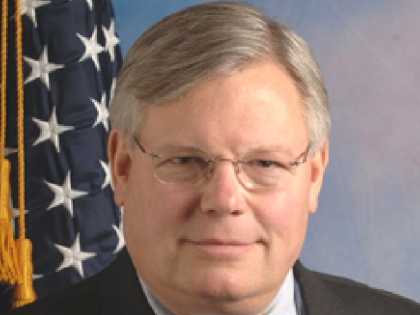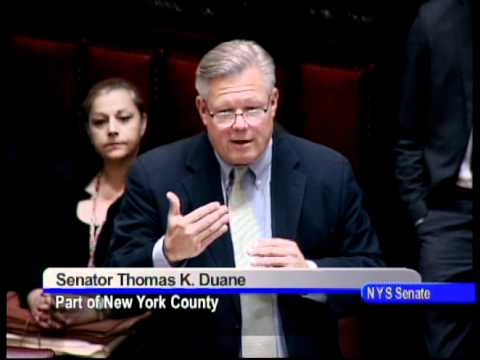
Testimony Of New York State Senator Thomas K. Duane To The New York City Council Committee On Health Regarding The Rise In Hiv/aids Among Young Men Of Color Who Have Sex With Men
My name is Thomas K. Duane and I represent New York State's 29th Senate District. I am also a member of the New York State AIDS Advisory Council. Thank you for the opportunity to present testimony before the New York City Council Committee on Healthfs oversight hearing regarding the rise in HIV/AIDS among young men of color who have sex with men (MSM).
As a longtime advocate for people living with HIV/AIDS and in the fight against the spread of HIV/AIDS, I applaud City Council Speaker Quinn and Council Members Rivera and James for holding this timely and critical hearing. The hard truth is that not only is HIV/AIDS still spreading three decades after the epidemic began, but prevalence is disturbingly high among young MSM of color.
A June 2005 Center for Disease Control (CDC) report detailed the bleak results of a study it had conducted of four American cities, including New York City. As in earlier reports, the CDC found that not only is the highest rate of HIV prevalence in young black MSM, but that demographic is also unfortunately the most likely to be unaware of their HIV status. The April 17, 2008 Gay City News article "An Epidemic Unabated," cited New York City data indicating that 3,596 13- to 24-year-olds first received an HIV diagnosis from 2001 to 2006, and among those who were male, 52 percent were African-American and 34 percent were Latino. The fact that any young people test positive for HIV nearly three decades after the epidemic began, given our understanding of how transmission can be prevented, is devastating. The fact that the overwhelming majority of them are men of color underscores the critical challenge that we must address with concerted and immediate action.
It is because we have known so much for so long with regards to the methods of HIV transmission that studies like these, which show a striking rise in HIV prevalence among certain demographics, are so shocking. That young people like those in these studies still participate in unsafe behaviors points to a lack of specific, frequently-imparted information during their formative years. Rising HIV rates are in part a result of inadequate HIV/AIDS education in our school system. Molding the behavior of young people before they are sexually active is vital to reducing the rate of HIV cases in our communities and in our city. We need to be doing more and we need to continue to do more for HIV/AIDS education from the earliest grades through high school. Explicit sex education for all young people and all those who continue to be at risk is essential to stop the spread of HIV/AIDS. We must not allow future HIV prevalence studies to repeat such bleak results for young MSM of color, or any young people.
The growing epidemic among MSM of color is not a new revelation to the hardworking community-based organizations that focus on this population. In particular, the New York State Black Gay Network, a coalition of 16 groups, has been instrumental in pushing this issue into the spotlight. The Network knows that education and prevention programs that have proven relatively successful with one group of people may not be effective for another. The "We Are Part of You" campaign, an effort to fight homophobia and promote safe-sex methods in communities of color, is just one tool that the Black Gay Network has utilized in its advocacy. Members of the Black Gay Network include the Gay Men's Health Crisis (GMHC), People of Color in Crisis, Gay Men of African Descent (GMAD), the Ali Forney Center, Harlem United, and the Community HIV/AIDS Mobilization Project (CHAMP), among others.
Each of the member organizations has done its part in educating young MSM of color about the harsh reality that they are a high-risk group and need to protect themselves and each other. For example, GMHC's "I Love My Boo" campaign features positive images of men of color together with the tagline "Safer sex is one way we show our love" on every poster. Its outreach to these young men through various volunteer-driven initiatives like "Soul Food," "Proyecto P.A.P.I.," and "Gay Gotham" show why GMHC is considered a leader in the fight against HIV/AIDS, and demonstrates its understanding of, and commitment to ending, the rise of HIV/AIDS in this demographic. GMAD's mobile testing vans and T.I.M.E.S. Project are other examples of a Network member using innovative techniques to fight the spread of HIV/AIDS among young MSM. While these efforts are making a difference, it is clear that the City needs to do more. I know that the Network was instrumental in securing this oversight hearing and I anticipate that its members' collective expertise will serve as a guide for the Committee on Health today as it explores appropriate reactions to this trend.
I am hopeful that today's oversight hearing will do much to inform the Council and the general public about the grave trend of increased HIV prevalence among young MSM. That HIV/AIDS is affecting so disproportionately one demographic indicates that something about current methods of prevention outreach is not working, and cries for a response tailored to the needs of this community. I do not pretend to have the answer to solving this problem, however, one thing that is clear is that access to regular health care is crucial to prevention and early detection, and therefore reducing further transmissions. We must end the appalling lack of equal access to health care across different communities in our City and State, and we must take this inequity into consideration as we look to address this current crisis.
I thank the City Council's Committee on Health for holding this hearing and look forward to working with you in the future to reverse this devastating trend.

